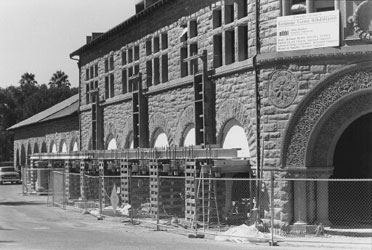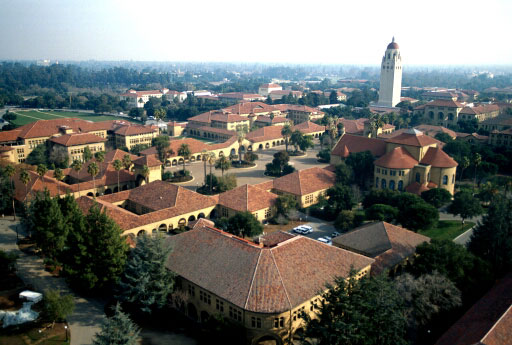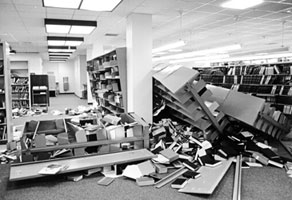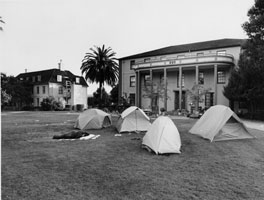|
|
||||||||||
 |
|
|
|
|||||||
|
|
||||||||||
|
|
|
|
|
|
|
|
|
|||
|
|
|
|
|
|
|
|
|
|
|
|
Themes | Stanford & 1989's Loma Prieta Quake
Fallen bookcases in Green Library after the 1989 quake. Courtesy Stanford News Service. |
Eighty-three years after the 1906 earthquake, the Stanford campus again was rocked by a severe quake. Although there were similarities in how the two quakes affected campus, the intervening years had seen much advancement in building safety and earthquake preparedness, which proved to be of benefit. In 1989, there were no deaths and no serious injuries on campus, although the student population was eight times that of 1906, the total faculty was more than 1,300, and staff members on campus each day numbered in the thousands. In 1906, the quake occurred as the day was beginning, and in 1989, the quake struck as the workday was ending.
At least one thousand students were not allowed to return to their residences that first night, and in an echo of 1906, some students pitched tents on lawns and slept out of doors. None of the large dormitory complexes was closed (Roble Hall had just undergone seismic strengthening), but a number of Row Houses suffered minor to severe damage, necessitating the relocation of hundreds of students. The earthquake closed three residential co-operative houses indefinitely due to significant structural damage. In response, displaced students designed a SWOPSI (Student Workshop on Political and Social Issues) class, called “Co-operative Living and the Current Crisis at Stanford.” The class was taught winter quarter 1990, and students produced a report that includes a timeline of events following the quake. Their effort to keep co-operative living alive on campus, in spite of displacement, also is documented.
As in 1906, students slept on the lawn following the 1989 Loma Prieta quake. Courtesy Stanford News Service |
Compared to approximately 50 buildings on campus in 1906, there were at least 400 structures built by 1989. As was the case in 1906, assessment of damage in 1989 began almost immediately and continued the following day. Haresh Shah, chairman of the Civil Engineering Department and a leading earthquake expert, was touring buildings on campus shortly after the earthquake occurred. University staff from Facilities Projects Management, graduate students in structural engineering, and volunteers formed teams to quickly determine which buildings were safe and which were unsafe. The following morning, inspection teams did a more thorough review of campus. Many of the older buildings had suffered the most. Memorial Church, Outer Quad buildings (Geology and Language Corners), the Museum, the Graduate School of Business (built on the location of the Library demolished in the 1906 quake), and Green Library were among the damaged buildings. The quake resulted in the closure of twenty-six buildings, and severely restricted access to thirty-four others. Despite the number of buildings affected, by Thursday, October 19, students, faculty, and staff returned to classes and work. The university was closed only one day.
With a few exceptions, campus libraries were reopened within three days of the earthquake. In contrast to 1906, when the library boasted nearly 86,000 volumes in its collection, in 1989 over five million volumes were held in the main and branch libraries on campus. After the shaking stopped, more than 750,000 volumes required reshelving, a task accomplished by staff and student volunteers. New shelving, properly braced, was necessary in a number of libraries, along with minor repairs. It was the damage done by the quake to Green Library West (now the Bing Wing of Green Library), which was the most painful to many in the university community.
In 1919, Stanford opened its new Library, located to the east of the Main Quadrangle, as the replacement for the library demolished by the 1906 quake. Designed by the San Francisco architectural firm, Bakewell and Brown, the Beaux Arts building was a steel frame construction, incorporating hollow clay-tile walls and reinforced concrete. Badly shaken eighty years after its opening, Green Library West required a major structural redesign. Seismically strengthened and completely refurbished, the Bing Wing, named to honor donors Peter and Helen Bing, reopened in October 1999.

Reconstruction of Language Corner after 1989. Courtesy Stanford News Service.
Restoration of campus buildings following the 1989 earthquake took more than a decade to complete. Important financial assistance was provided by the Federal Emergency Management Agency and many generous donors. Restoration of Memorial Church, for which FEMA funds could not be used, was completed by November 1992. Green Library, the Museum (now the Cantor Center for Visual Arts), Hanna House (the Frank Lloyd Wright house), and various Quad buildings were back in operation by the end of the decade. In addition to repair and restoration of buildings damaged in the quake, Stanford undertook upgrades on other campus structures to bring them up to current standards of seismic strength.


